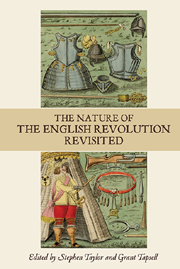Book contents
- Frontmatter
- Contents
- Preface and Acknowledgements
- List of contributors
- List of Abbreviations
- 1 Charles I and Public Opinion on the Eve of the English Civil War
- 2 Rethinking Moderation in the English Revolution: The Case of An Apologeticall Narration
- 3 The Parish and the Poor in the English Revolution
- 4 Body Politics in the English Revolution
- 5 The franchise Debate Revisited: The Levellers and the Army
- 6 Oliver Cromwell and the Instrument of government
- 7 ‘de te fabula narratur’: The Narrative Constitutionalism of James Harrington's Oceana
- 8 Democracy in 1659: Harrington and the Good Old Cause
- 9 The Restoration of the Church of England, 1660–1662: Ordination, Re-ordination and Conformity
- 10 Style, Wit and Religion in Restoration England
- 11 A British Patriarchy? Ecclesiastical Imperialism under the Later Stuarts
- Index
- Studies in Early Modern Cultural, Political and Social History
10 - Style, Wit and Religion in Restoration England
Published online by Cambridge University Press: 05 July 2013
- Frontmatter
- Contents
- Preface and Acknowledgements
- List of contributors
- List of Abbreviations
- 1 Charles I and Public Opinion on the Eve of the English Civil War
- 2 Rethinking Moderation in the English Revolution: The Case of An Apologeticall Narration
- 3 The Parish and the Poor in the English Revolution
- 4 Body Politics in the English Revolution
- 5 The franchise Debate Revisited: The Levellers and the Army
- 6 Oliver Cromwell and the Instrument of government
- 7 ‘de te fabula narratur’: The Narrative Constitutionalism of James Harrington's Oceana
- 8 Democracy in 1659: Harrington and the Good Old Cause
- 9 The Restoration of the Church of England, 1660–1662: Ordination, Re-ordination and Conformity
- 10 Style, Wit and Religion in Restoration England
- 11 A British Patriarchy? Ecclesiastical Imperialism under the Later Stuarts
- Index
- Studies in Early Modern Cultural, Political and Social History
Summary
This paper elevates style above substance. It speculates on the significance of literary style in debates over religious difference during the reign of Charles II, and it does so because contemporaries frequently remarked upon an author's ‘style’. The notorious clerical controversialist Samuel Parker boasted ‘a brave, flourishing, lofty stile’ or, to another's mind, ‘writ in a stile so vindictive and poynant’, while Simon Patrick displayed a ‘flouting, scoffing, jeering style’, and Andrew Marvell ‘led the way’ in the fashion for ‘a buffooning, burlesquing and ridiculing way and stile’. ‘Your style is so Exasperating,’ complained a critic of John Eachard's writings: it is ‘Lofty and Swaggering’. It was precisely ‘the Ornament of their Style, and the pleasantness of their method, and subtilty of their Wit’ that might allow dangerously heterodox writers to beguile and mislead their readers. Even Sir Robert Filmer's ‘plausible Stile’ made an effective case, conceded Locke, if not a sound argument, for his glib nonsense. ‘Style’ as used in these and other examples has a meaning that lies somewhere between the modern conception of that quality which characterises a text or an author and the traditional notion of eiocutio, the ornamentation of one's words, one of the five components of classical rhetoric. The Restoration's broad use of the term matched the diversity of stylistic practice among contemporary prose writers.
- Type
- Chapter
- Information
- The Nature of the English Revolution Revisited , pp. 233 - 260Publisher: Boydell & BrewerPrint publication year: 2013



